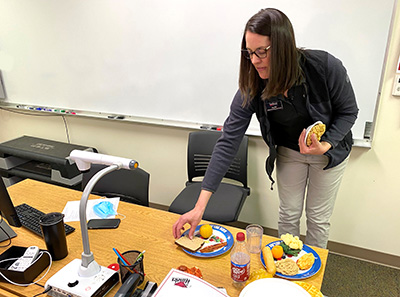NORFOLK, Neb. – Healthy eating is not designed to be incorporated occasionally into one’s diet. It takes a firm commitment to ensure that everyone eats a proper diet on a regular basis to maintain a healthy lifestyle.
National Nutrition Month® is an annual campaign created by the Academy of Nutrition and Dietetics that is designed to encourage individuals to learn about making informed food choices and developing healthful eating and physical activity habits.
Amy Ries, health & physical education instructor at Northeast Community College, said the observance is designed to get people interested in nutrition and to have it front of mind to get them to think differently about how they eat, where they get their food, as well as experimenting with different foods.
One important factor anyone should do when starting a new diet plan is to be in touch with their physician. Individuals should speak with their healthcare provider to be checked to make sure their weight is stable and they are not gaining or losing weight rapidly, especially if they did not intend to. Ries, a registered dietician, said it is also good to monitor vital signs such as blood sugar levels, blood pressure, and cholesterol, among others.
“You don’t want to let time go by and all of a sudden, you are carrying 20-to-25 pounds more than you were because you weren’t monitoring that,” Ries said. “That’s a very important thing – knowing your numbers and seeing and understanding what they are from month-to-month.”
Ries is a big believer in consuming a variety of foods, but limiting the amount when planning a diet. She said moderation is key - it’s not about eliminating certain foods from a diet, but portion control.
“Many people love chocolate ice cream and may start with two-to-four scoops in one serving and yet we eat it like it’s no problem. People just need to be aware of the amount of carbohydrates or simple sugar they’re taking in through portion sizes. Instead, have two or three bites of ice cream instead of two or three scoops of it.”
This is especially true in the elderly population. As more people have been staying home during the pandemic, they may not have been getting in as much activity as in the past, and therefore, they are more sedentary and their weight may go up. Consequently, they may also be seeing it go down due to malnutrition which can lead to unintended weight loss.
When it comes to a healthy diet, a proper plate is colorful and includes a variety of fruits and vegetables. In addition, whole grains are important for any age group.
“So, for example, we would want to try brown rice and maybe even combine it with white rice,” Ries said. “You can also try things like whole wheat spaghetti, whole grain bread, and different cereals you haven’t tried before. That would be a great way to get those whole grains in. Also, a portion of the plate is a serving of meat.”
When it comes to fat, Ries uses a model to explain its effects to her students. She said they are shocked to learn that the one-pound model represents 3,500 calories of body fat.
“Sometimes the student-athletes I have in class say, ‘There’s no way I can just eat that much. I eat way more than that.’ And that’s okay,” Ries said. “It really depends on who has this plate in front of them. But in general, for the adult population it would be about a fourth of a plate of meat.”
Another area of discussion in the classroom has been the new food label’s definition of liquid calories.
“People need to recognize just how fast those calories can add up, especially if you are choosing to have pop quite often instead of water,” Ries said.
Good nutrition just doesn’t stop with planning meals, it’s also important to focus on activity. Now with warmer weather, Ries encourages people to get outside, if possible. This includes even just walking around the home and having proper footwear.
“A short walk can really be beneficial,” she said. “It doesn’t have to be miles and miles, especially if you’re just starting out. We always talk about starting out slowly because a day one exercise will look much different than a day 30 exercise. You really should plan ahead and make sure you’re not doing too much at the beginning.”
Another thing that can be done to maintain muscle mass is to use exercise bands or thera-bands, which are larger rubber bands that use resistance that allow for upper and lower body training.
“You don’t have to necessarily have to feel like you have to go to a gym or somewhere else to get your exercise in. We even speak with our students about teaching people to use things like bottles of water or canned goods to lift them like weights. Everyone seems to have those at home.
To learn more nutrition tips and advice, visit the Academy of Nutrition and Dietetics website at eatright.org/food/resources/national-nutrition-month.
--###--
PHOTO CUTLINE
Amy Ries, health & physical education instructor, shows some of the food models she uses in her nutrition classes at Northeast Community College. The topic was highlighted recently during National Nutrition Month.

